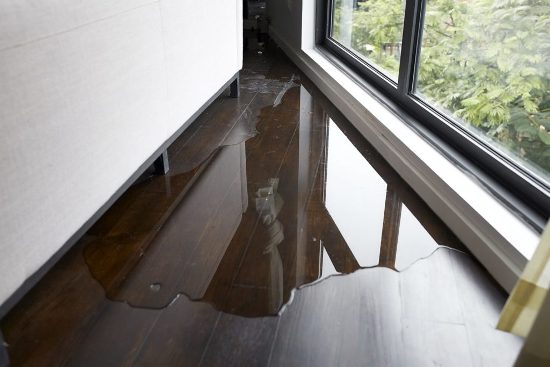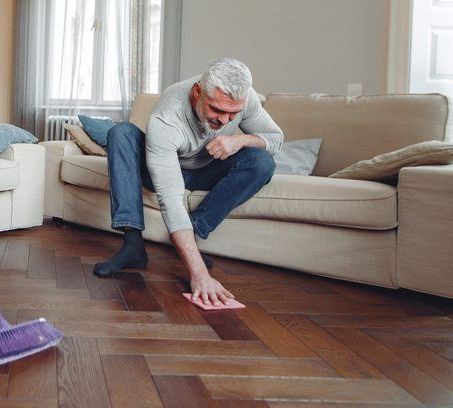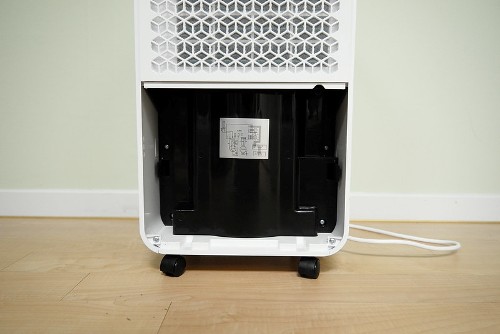Due to its necessity and commonness, water can appear in any spot of our house. This is the most dangerous enemy to the hardwood floor.
As a hardwood lover, I have faced water spills onto my hardwood floor several times. Previously, there was a time when I used to waste money and time on improper cleaning methods.
Then, after much research and from my own experience, I have come up with a thorough procedure to deal with water spill on hardwood floor, and I’d like to share it with you today.

Table of Contents
How To Deal With Water Spill On Hardwood Floor?
#1. Detecting The Derivation Of Leakage
For water spilling from a bucket, a bottle of water, or cups, you can skip this step. However, if one day you wake up and see water flooding or staying on your hardwood floor, you must find out its source.
This stage is crucial because you need to block the water source before carrying out further drying methods. Or else, it will keep flooding in during the drying stage and make your efforts useless.
There are some common water spill sources like water leakage from the sink or faucet, obscured holes on the roof, pipes burst, or obstructed sewer pipes. Once you spot where the water comes from, you should move on to pick some practical tools for handling water spills.
#2. Prepare Essential Tools
There are some tools you can opt for when facing water spill on your hardwood floor. I list them in the positions compatible with the order of the process in which you will need to utilize these tools:
- Mop or towel: These items soak up water on the floors.
- Wet vac: It works as an ordinary vacuum that can suck up liquid.
- Cleaning solutions for wood floors and scrub brushes: After drying the floors with the first four objects, you need to clean the debris and dirt left after the spill by using cleaning solutions and scrub brushes.
- Fan: For drying the surface of hardwood floors.
- Dehumidifier: This machine will limit or reduce the humidity in the air to make the water-covered floors dry faster.
#3. Take Out The Wet Items
When you find the water spill, you should relocate all the items within the water spill range to a dry place. By doing this, you can limit the total damage from the water spill.
What’s more, taking out the soaked items will help to prevent the water from saturating the floors and the unpleasant odor from the damp objects like rugs or carpets.
#4. Dry The Floor As Soon As Possible
When you finish moving the wet furniture away, you need to dry the floor immediately. I have divided the drying process into two different phases. You should complete the task instantly with handy tools like a towel or a mop at this phase.
The best solution is using a wet vac in the first drying phase. This machine will do all the work for you and ensure optimal efficiency. Yet, not everyone has a wet vac at home. In this case, you should turn to a towel or cloth.

Before anything, lay as many towels on the wet hardwood floor as you can to absorb more water than using a single towel. When the towels become wet, you have to squeeze them to transfer the excess water into a bucket. Then, redo the procedures until you notice that the floor is dry, or at least there won’t be any splash if you step on the floor.
Using a mop to dry the wood floor is similar to using a towel. Let the mop absorb the water, then squeeze it to extract water into a bucket, and redo the process.
#5. Sanitize The Floor
This sanitizing step will depend on the source of the water spill. For water spilling from a cup of water or a bottle of water you are drinking, you can ignore this step because the water is totally clean.
On the contrary, if the water is from water leakage, burst pipes, or obstructed sewer pipes, you must carry out the cleaning stage.
Along with these sources of water above, there is always mud, silt, or waste. For this reason, drying the floors without sanitizing them will result in mold and stinky odor generated by these dirty particles that can affect your health and the hardwood floors.
To wipe out the irritating debris, stain, and mud, you can rely on cleaning solutions and scrub brushes. You have to make sure that the cleaning solutions are suitable for the hardwood floors. If you don’t notice this point, the inappropriate liquid will damage your floors even more severely.
#6. Properly Dry The Floor
Unlike the first drying phase, where you have to dry the water as fast as you can, in this stage, carrying out the drying process more thoroughly to evaporate the water after reducing its level is a wiser option.
To boost the evaporation via excellent ventilation, you should open all the windows around the water spill area. Furthermore, set up as many fans as you can, and adjust the fans’ directions straight towards the damp spots to quickly dry them.
Then, when you don’t see any water left, you should use a meter to check the moisture level. The favorable proportion is from 6% to 9%. If the measuring result exceeds this figure, you should apply a dehumidifier to remove the moisture.
#7. Check Whether The Mold Appears
The damage won’t appear obviously and instantly after the water spill, making people think their cleaning work is effective. Whereas, in fact, the damage still silently emerges.
Luckily, you can still recognize the sign of damage via the quickly formed molds. After carrying out all the drying methods, you should spend more time checking the floors whether there is mold. Immediately eliminating the mold once it appears before it can generate more serious damage to the wood floors would be essential.
You should redo the second drying phase for more remarkable efficiency, especially taking advantage of the dehumidifier. Since moisture is the optimal environment for the thriving of mold, you need to significantly reduce the moisture level to tackle down its growing chances.
#8. Carry Out A Test For Moisture
You should perform this test after 30 days since your drying procedures. A moisture test at this period will guarantee that the hardwood floor is safe from the water spill, there is no damage, and you have successfully dealt with the water spill.
If things don’t go as you expect, there are still numerous molds and high moisture levels. You should apply the whole drying and cleaning process once again. Calling for help from an expert is also a highly recommended method if the problem seems to be out of control.
Bottom Lines
Water spill on hardwood floor is a complicated task to fulfill. Nevertheless, any hardwood floor owners will have to face this challenge sooner or later. Don’t be like me, who only tackle the problem when it comes up, but prepare yourself beforehand.
I hope that my tutorial will mean something to you. Carefully follow these steps above, and you can effortlessly dry and clean your water-soaked hardwood floors.
Related Post:
- How To Remove Mold From Wood Floors? Step-By-Step Instructions
- How To Restore Hardwood Floors After Removing Carpet – Home Care Tips
- Can Swiffer Wetjet Be Used On Hardwood Floors? An Insight Answer
- What Causes White Spots on Hardwood Floors and How to Remove? – Home Care Q&A

